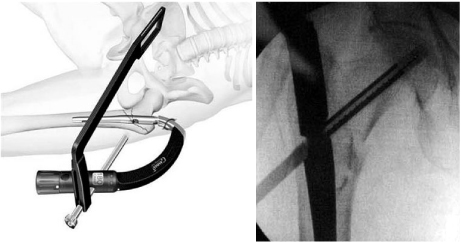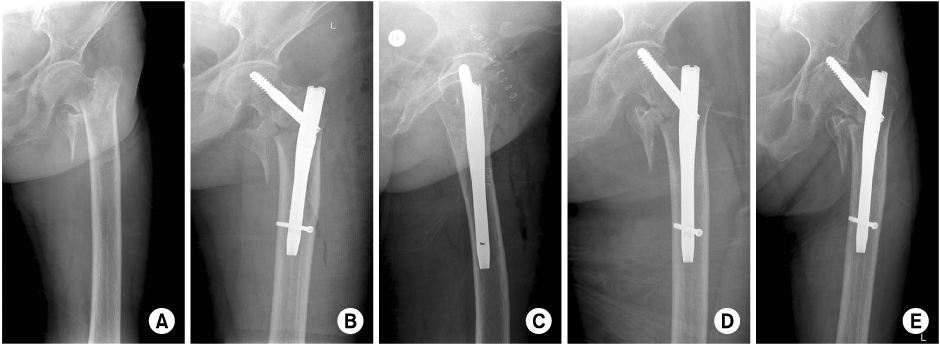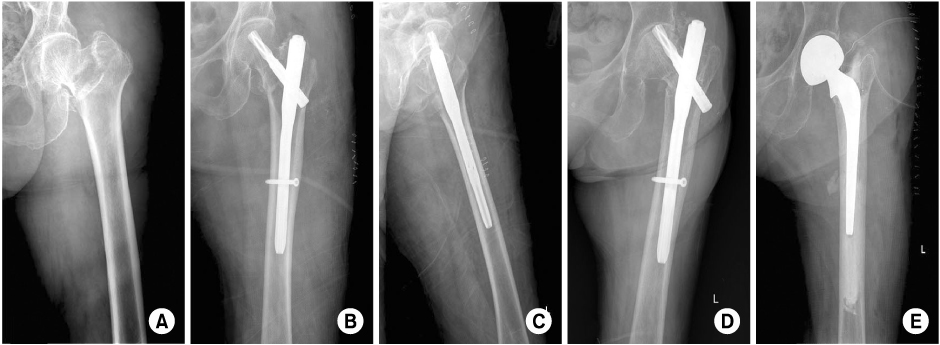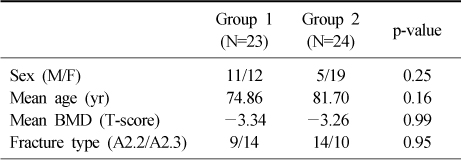Articles
- Page Path
- HOME > J Musculoskelet Trauma > Volume 26(1); 2013 > Article
-
Original Article
- Comparative Study of Intertrochanteric Fracture Treated with the Proximal Femoral Nail Anti-Rotation and the Third Generation of Gamma Nail
- Jae-Cheon Sim, M.D., Tae-Ho Kim, M.D., Ki-Do Hong, M.D., Sung-Sik Ha, M.D., Jong-Seong Lee, M.D.
-
Journal of the Korean Fracture Society 2013;26(1):37-43.
DOI: https://doi.org/10.12671/jkfs.2013.26.1.37
Published online: January 17, 2013
Department of Orthopaedic Surgery, Sahmyook Medical Center, Seoul, Korea.
- Address reprint requests to: Tae-Ho Kim, M.D. Department of Orthopaedic Surgery, Sahmyook Medical Center, 82, Mangu-ro, Dongdaemun-gu, Seoul 130-711, Korea. Tel: 82-2-2210-3320, Fax: 82-2-2212-2673, likeapple111@naver.com
• Received: August 2, 2012 • Revised: October 2, 2012 • Accepted: November 11, 2012
Copyright © 2013 The Korean Fracture Society
- 1,251 Views
- 5 Download
- 4 Crossref
Abstract
-
Purpose
- To compare the result between the third generation gamma nail (gamma 3 nail) and proximal femoral nail anti-rotation (PFNA) in the treatment of unstable intertrochanteric fractures.
-
Materials and Methods
- Between March 2009 and June 2011, 47 consecutive patients with unstable intertrochanteric femoral fractures were treated with gamma 3 nail or PFNA. We reviewed 24 cases of gamma 3 nail and 23 cases of PFNA. Retrospectively, we evaluated the mean operation time, amount of bleeding, average union period, reduction status, change of neck shaft angle, Tip-apex distance, Cleveland index, sliding of lag screw and complication on set of telephone interview and outpatient. We also evaluated the postoperative capability of function and mobility, using 'Modified Koval index'.
-
Results
- There were no significant differences between the groups, which were treated with gamma 3 nail and PFNA. In addition, they did not show statistical difference. We experienced 2 cases of complication (gamma 3 nail 1 case, PFNA 1 case), which were cut-out of the femoral head.
-
Conclusion
- The gamma 3 nail and PFNA were seen with good results in the treatment of unstable intertrochanteric fracture.
- 1. Al-yassari G, Langstaff RJ, Jones JW, Al-Lami M. The AO/ASIF proximal femoral nail (PFN) for the treatment of unstable trochanteric femoral fracture. Injury, 2002;33:395-399.Article
- 2. Aune AK, Ekeland A, Odegaard B, Grøgaard B, Alho A. Gamma nail vs compression screw for trochanteric femoral fractures. 15 reoperations in a prospective, randomized study of 378 patients. Acta Orthop Scand, 1994;65:127-130.Article
- 3. Buciuto R, Uhlin B, Hammerby S, Hammer R. RAB-plate vs Richards CHS plate for unstable trochanteric hip fractures. A randomized study of 233 patients with 1-year follow-up. Acta Orthop Scand, 1998;69:25-28.Article
- 4. Cleveland M, Bosworth DM, Thompson FR, Wilson HJ Jr, Ishizuka T. A ten-year analysis of intertrochanteric fractures of the femur. J Bone Joint Surg Am, 1959;41:1399-1408.Article
- 5. Davis TR, Sher JL, Horsman A, Simpson M, Porter BB, Checketts RG. Intertrochanteric femoral fractures. Mechanical failure after internal fixation. J Bone Joint Surg Br, 1990;72:26-31.ArticlePDF
- 6. Doppelt SH. The sliding compression screw--today's best answer for stabilization of intertrochanteric hip fractures. Orthop Clin North Am, 1980;11:507-523.Article
- 7. Fogagnolo F, Kfuri M Jr, Paccola CA. Intramedullary fixation of pertrochanteric hip fractures with the short AO-ASIF proximal femoral nail. Arch Orthop Trauma Surg, 2004;124:31-37.ArticlePDF
- 8. Forte ML, Virnig BA, Kane RL, et al. Geographic variation in device use for intertrochanteric hip fractures. J Bone Joint Surg Am, 2008;90:691-699.Article
- 9. Gundle R, Gargan MF, Simpson AH. How to minimize failures of fixation of unstable intertrochanteric fractures. Injury, 1995;26:611-614.Article
- 10. Halder SC. The gamma nail for peritrochanteric fractures. J Bone Joint Surg Br, 1992;74:340-344.ArticlePDF
- 11. Haynes RC, Pöll RG, Miles AW, Weston RB. Failure of femoral head fixation: a cadaveric analysis of lag screw cut-out with the gamma locking nail and AO dynamic hip screw. Injury, 1997;28:337-341.Article
- 12. Hong KD, Sim JC, Ha SS, Kim TH, Choi YH, Kim JH. Operative treatment with gamma 3 nail in femur intertrochanteric fracture. J Korean Fract Soc, 2011;24:7-15.Article
- 13. Jensen JS, Sonne-Holm S, Tøndevold E. Unstable trochanteric fractures. A comparative analysis of four methods of internal fixation. Acta Orthop Scand, 1980;51:949-962.Article
- 14. Kim TH, Kim JO, Lee SY, Yun GU. Treatment of the unstable intertrochanteric fracture with proximal femoral nail antirotation: comparison with compression hip screw with trochanteric stabilizing plate. J Korean Fract Soc, 2010;23:353-359.Article
- 15. Koval KJ, Cantu RV. Rookwood CA, Green DP. Intertrochanteric fractures. In: Fractures in adults, 2006;6th ed. Philadelphia, JB Lippincott. 1793-1825.Article
- 16. Koval KJ, Skovron ML, Aharonoff GB, Meadows SE, Zuckerman JD. Ambulatory ability after hip fracture. A prospective study in geriatric patients. Clin Orthop Relat Res, 1995;(310):150-159.
- 17. Koval KJ, Zuckerman JD. Hip fractures: II. Evaluation and treatment of intertrochanteric fractures. J Am Acad Orthop Surg, 1994;2:150-156.Article
- 18. Kyle RF, Cabanela ME, Russell TA, et al. Fractures of the proximal part of the femur. Instr Course Lect, 1995;44:227-253.Article
- 19. Lacroix H, Arwert H, Snijders CJ, Fontijne WP. Prevention of fracture at the distal locking site of the gamma nail. A biomechanical study. J Bone Joint Surg Br, 1995;77:274-276.ArticlePDF
- 20. Lee JY, Lee SY. Treatment of the proximal femoral extracapsular fracture with proximal femoral nail antirotation (PFNA): comparison with proximal femoral nail (PFN). J Korean Hip Soc, 2007;19:183-189.Article
- 21. Loch DA, Kyle RF, Bechtold JE, Kane M, Anderson K, Sherman RE. Forces required to initiate sliding in second-generation intramedullary nails. J Bone Joint Surg Am, 1998;80:1626-1631.Article
- 22. Mereddy P, Kamath S, Ramakrishnan M, Malik H, Donnachie N. The AO/ASIF proximal femoral nail antirotation (PFNA): a new design for the treatment of unstable proximal femoral fractures. Injury, 2009;40:428-432.Article
- 23. Mulholland RC, Gunn DR. Sliding screw plate fixation of intertrochanteric femoral fractures. J Trauma, 1972;12:581-591.Article
- 24. Müller ME, Nazarian S. Classification of fractures of the femur and its use in the A.O. index (author's transl). Rev Chir Orthop Reparatrice Appar Mot, 1981;67:297-309.
- 25. Nakata K, Ohzono K, Hiroshima K, Toge K. Serial change of sliding in intertrochanteric femoral fractures treated with sliding screw system. Arch Orthop Trauma Surg, 1994;113:276-280.ArticlePDF
- 26. Nunn D. Sliding hip screws and medial displacement osteotomy. J R Soc Med, 1988;81:140-142.ArticlePDF
- 27. Oh JK, Hwang JH. Osteoporotic pertrochanteric fracture: IM nailing. J Korean Fract Soc, 2009;22:56-65.Article
- 28. Oh KJ, Lee ST, Lee SH, Hwang JH, Kang MS. Helical blade versus lag screw for treatment of intertrochanteric fracture. J Korean Fract Soc, 2010;23:6-12.
- 29. Park JH, Park JW, Wang JH, Lee JW, Lee JI, Kim JG. Treatment of intertrochanteric fracture: comparison of proximal femoral nail and proximal femoral nail A. J Korean Fract Soc, 2008;21:103-109.Article
- 30. Park MS, Lim YJ, Kim YS, Kim KH, Cho HM. Treatment of the proximal femoral fractures with proximal femoral nail antirotation (PFNA). J Korean Fract Soc, 2009;22:91-97.Article
- 31. Rha JD, Kim YH, Yoon SI, Park TS, Lee MH. Factors affecting sliding of the lag screw in intertrochanteric fractures. Int Orthop, 1993;17:320-324.ArticlePDF
- 32. Rosenblum SF, Zuckerman JD, Kummer FJ, Tam BS. A biomechanical evaluation of the gamma nail. J Bone Joint Surg Br, 1992;74:352-357.
- 33. Sadowski C, Lübbeke A, Saudan M, Riand N, Stern R, Hoffmeyer P. Treatment of reverse oblique and transverse intertrochanteric fractures with use of an intramedullary nail or a 95 degrees screw-plate: a prospective, randomized study. J Bone Joint Surg Am, 2002;84:372-381.
- 34. Simmermacher RK, Ljungqvist J, Bail H, et al. AO-PFNA studygroup. The new proximal femoral nail antirotation (PFNA) in daily practice: results of a multicentre clinical study. Injury, 2008;39:932-939.Article
- 35. Sommers MB, Roth C, Hall H, et al. A laboratory model to evaluate cutout resistance of implants for pertrochanteric fracture fixation. J Orthop Trauma, 2004;18:361-368.Article
- 36. Strauss E, Frank J, Lee J, Kummer FJ, Tejwani N. Helical blade versus sliding hip screw for treatment of unstable intertrochanteric hip fractures: a biomechanical evaluation. Injury, 2006;37:984-989.
- 37. Templeman D, Baumgaertner MR, Leighton RK, Lindsey RW, Moed BR. Reducing complications in the surgical treatment of intertrochanteric fractures. Instr Course Lect, 2005;54:409-415.
- 38. Thomas AP. Dynamic hip screws that fail. Injury, 1991;22:45-46.Article
- 39. Utrilla AL, Reig JS, Muñoz FM, Tufanisco CB. Trochanteric gamma nail and compression hip screw for trochanteric fractures: a randomized, prospective, comparative study in 210 elderly patients with a new design of the gamma nail. J Orthop Trauma, 2005;19:229-233.
- 40. Yaozeng X, Dechun G, Huilin Y, Guangming Z, Xianbin W. Comparative study of trochanteric fracture treated with the proximal femoral nail anti-rotation and the third generation of gamma nail. Injury, 2010;41:1234-1238.
REFERENCES
Fig. 1Gamma 3 nail using sure shot guide of gamma 3 nail help determine correct nail positioning to allow proper placement of the lag screw.


Fig. 2
(A) A 85-year-old female patient presented with intertrochanteric fracture as AO/ASIF classification A2.3.
(B) Postoperative radiograph which is fixed with gamma 3 nail.
(C) Lateral view of postoperative radiograph.
(D) Postoperative 2 weeks radiograph shows cutting out of the lag screw.
(E) Postoperative 12 weeks radiographs show a aggravation of cut-out complication (Patient refused a re-operation.).


Fig. 3
(A) A 59-year-old female patient presented with intertrochanteric fracture as AO/ASIF classification A2.2.
(B) Postoperative radiograph which is fixed with proximal femoral nail anti-rotation (PFNA).
(C) Lateral view of postoperative radiograph.
(D) Postoperative 6 months radiograph shows cutting out of the PFNA blade.
(E) Reoperation was done with cemented bipolar hemiarthroplasty.


Figure & Data
REFERENCES
Citations
Citations to this article as recorded by 

- Comparative analysis of operation time and intraoperative fluoroscopy time in intramedullary and extramedullary fixation of trochanteric fractures
Milan Mitkovic, Sasa Milenkovic, Ivan Micic, Predrag Stojiljkovic, Igor Kostic, Milorad Mitkovic
Vojnosanitetski pregled.2022; 79(2): 177. CrossRef - Does the Helical Blade Lead to Higher Rates of Fixation Failure as Compared to Lag Screw in the Cephalomedullary Nailing Treatment of Hip Fractures? A Systematic Review and Meta-Analysis
Chul-Ho Kim, Han Soul Kim, Yong-Chan Kim, Dou Hyun Moon
Journal of Orthopaedic Trauma.2021; 35(8): 401. CrossRef - The Curative Effect Comparison Between Prolonged Third Generation of Gamma Nail and Prolonged Dynamic Hip Screw Internal Fixation in Treating Femoral Intertrochanteric Fracture and the Effect on Infection
Wenye He, Wei Zhang
Cell Biochemistry and Biophysics.2015; 71(2): 695. CrossRef - Accuracy of the Lesser Trochanter for Guiding Lag Screw Insertion in Hip Fracture Management
Jianlin Xiao, Zhongli Gao, Yanguo Qin, Xuezhou Li, Ao Wang, Lanyu Zhu, Jincheng Wang
Orthopedics.2014;[Epub] CrossRef
Comparative Study of Intertrochanteric Fracture Treated with the Proximal Femoral Nail Anti-Rotation and the Third Generation of Gamma Nail



Fig. 1
Gamma 3 nail using sure shot guide of gamma 3 nail help determine correct nail positioning to allow proper placement of the lag screw.
Fig. 2
(A) A 85-year-old female patient presented with intertrochanteric fracture as AO/ASIF classification A2.3.
(B) Postoperative radiograph which is fixed with gamma 3 nail.
(C) Lateral view of postoperative radiograph.
(D) Postoperative 2 weeks radiograph shows cutting out of the lag screw.
(E) Postoperative 12 weeks radiographs show a aggravation of cut-out complication (Patient refused a re-operation.).
Fig. 3
(A) A 59-year-old female patient presented with intertrochanteric fracture as AO/ASIF classification A2.2.
(B) Postoperative radiograph which is fixed with proximal femoral nail anti-rotation (PFNA).
(C) Lateral view of postoperative radiograph.
(D) Postoperative 6 months radiograph shows cutting out of the PFNA blade.
(E) Reoperation was done with cemented bipolar hemiarthroplasty.
Fig. 1
Fig. 2
Fig. 3
Comparative Study of Intertrochanteric Fracture Treated with the Proximal Femoral Nail Anti-Rotation and the Third Generation of Gamma Nail
Demographic Characteristics between the Group 1 and 2
M: Male, F: Female, BMD: Bone mineral density.
Immediately Postoperative Reduction Status
Comparison of Radiographic Results
Comparison of Dlinical Results
preop: Preoperative, postop: Postoperative.
Table 1
Demographic Characteristics between the Group 1 and 2
M: Male, F: Female, BMD: Bone mineral density.
Table 2
Immediately Postoperative Reduction Status
Table 3
Comparison of Radiographic Results
Table 4
Comparison of Dlinical Results
preop: Preoperative, postop: Postoperative.

 E-submission
E-submission KOTA
KOTA TOTA
TOTA TOTS
TOTS




 Cite
Cite

